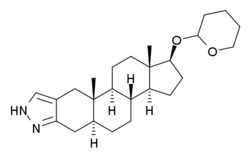Prostanozol
Prostanozol, also known as demethylstanozolol tetrahydropyran ether, is an androgen/anabolic steroid (AAS) and designer steroid which acts as a prodrug of the 17α-demethylated analogue of stanozolol (Winstrol). It was found in 2005 as an ingredient of products sold as "dietary supplements" for bodybuilding.[1]
 | |
| Clinical data | |
|---|---|
| Other names | 17α-Demethylstanozolol 17β-tetrahydropyran ether; 17β-[(Tetrahydro-2H-pyran-2-yl)oxy]-5α-androst-2-eno[3,2-c]pyrazole; [3,2-c]Pyrazole-5α-etioallocholane-17β-tetrahydropyranol; 17β-[(Tetrahydro-2H-pyran-2-yl)oxy]-2'H-5α-androst-2-eno[3,2-'c]pyrazole; Pyrazolo[4',3':2,3]-5α-androstan-17β-ol 17β-tetrahydropyran ether |
| Routes of administration | By mouth |
| Drug class | Androgen; Anabolic steroid; Androgen ether |
| Identifiers | |
IUPAC name
| |
| CAS Number | |
| PubChem CID | |
| ChemSpider | |
| UNII | |
| Chemical and physical data | |
| Formula | C25H38N2O2 |
| Molar mass | 398.580 g/mol g·mol−1 |
| 3D model (JSmol) | |
SMILES
| |
| (verify) | |
It is one of hundreds of drugs banned from the Olympics by the IOC.[2] Russian marathon runner Lyubov Denisova was banned for two years from competition after testing positive for prostanozol and testosterone in 2007.[3]
References
- Eenoo PV, Delbeke FT. Metabolism and excretion of anabolic steroids in doping control—New steroids and new insights. Journal of Steroid Biochemistry and Molecular Biology. 2006;101(4-5):161-178. doi:10.1016/j.jsbmb.2006.06.024
- "192 Banned Performance Enhancing Substances and Methods". ProCon.org. March 17, 2010. Retrieved July 25, 2015.
- "Russian marathon runner Denisova banned for 2 years for doping". USA Today. May 15, 2007. Retrieved July 25, 2015.
This article is issued from
Wikipedia.
The text is licensed under Creative
Commons - Attribution - Sharealike.
Additional terms may apply for the media files.